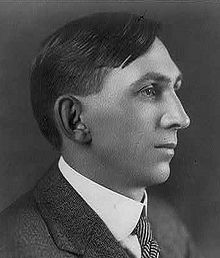- Charles Wakefield Cadman
-
Charles Wakefield Cadman (December 24, 1881 – December 30, 1946) was an American composer.
Cadman’s musical education, unlike that of most of his American contemporaries, was completely American. Born in Johnstown, Pennsylvania, he began piano lessons at 13. Eventually, he went to nearby Pittsburgh where he studied harmony, theory, and orchestration with Luigi von Kunits and Emil Paur, then concertmaster and conductor, respectively, of the Pittsburgh Symphony Orchestra. This was the sum of his training. He was named a national honorary member of Phi Mu Alpha Sinfonia music fraternity in 1915.
In 1908 Cadman was appointed the music editor and critic of the Pittsburgh Dispatch.[1] He was greatly influenced by American Indian music and went to Nebraska to make cylinder recordings of tribal melodies for the Smithsonian Institution. He lived with the Omaha and Winnebago tribes on their reservations, learning to play their instruments. He used elements of traditional music in the form of his compositions of 19th-century romantic music.
Publishing several articles on American Indian music, Cadman was regarded as one of the foremost experts on the subject. He toured both the States and Europe giving his then-celebrated "Indian Talk". But his involvement with the so-called Indianist movement in American music contributed to some critics failing to judge his works on their own merits.
Cadman's early works enjoyed little success until the famous soprano Lillian Nordica sang his "From the Land of the Sky-Blue Water," and Indian-influenced song. Another Indian-influenced song which became well-known in the 1920s was "At Dawning".
Cadman eventually moved to Los Angeles. He helped to found and often performed as a soloist with the Hollywood Bowl Orchestra. He wrote the scores for several films, including The Sky Hawk, Captain of the Guard, Women Everywhere, and Harmony at Home. Along with Dmitri Tiomkin, he was considered one of Hollywood’s top film composers.
But Cadman first and foremost was a serious composer who wrote for nearly every genre. His chamber music works are generally considered among his best. He introduced elements of ragtime music into the classical music format, anticipating Gershwin, Stravinsky, and Milhaud, among others. His Piano Trio, Op. 56, composed in 1913, drew the critics' attention and praise for his innovations.
The Pageant of Colorado, a historical pageant with music composed by Cadman, was produced in Denver, Colorado in May 1927 under the direction of dramatist and playwright Percy Jewett Burrell, a fraternity colleague of Cadman.
His opera The Sunset Trail (1922) was part of the touring repertoire of Vladimir Rosing's American Opera Company. He also composed music for Da O Ma, an opera based on Omaha traditions, with a libretto written by Nelle Eberhart and Francis La Flesche, an Omaha ethnologist with the Smithsonian.[2]
Selected works
- Operas and operettas
- The Land of the Misty Waters (1912)
- Shanewis or The Robin Woman (1918)
- The Sunset Trail (1922)
- The Garden of Mystery (1925, after Rappaccini's Daughter)
- Lelawala (1926)
- A Witch of Salem (1926)
- The Belle of Havana (1928)
- South of Sonora (1932)
- Ramala (undated)
- American Indian art songs
- Four American Indian Songs, Op. 57; words by Nelle Richmond Eberhart; Edwin H. Morris publisher, 1914
- The Place of Breaking Light
- From the Long Room of the Sea
- Ho, Ye Warriors on the Warpath
- The Thunderbirds Come from the Cedars
- The Doe-Skinned Blanket; words by Cecil Fanning; Edwin H. Morris publisher, 1919
- From the Land of the Sky-Blue Water, Op. 45 No. 1; words by Nelle Richmond Eberhart; White-Smith Music Publishing Co., 1909
- Her Shadow (Ojibway Canoe Song); words by Frederick R. Burton; Edwin H. Morris publisher, 1918
- He Who Moves in the Dew; words by Nelle Richmond Eberhart; Edwin H. Morris publisher, 1916
- I Found Him on the Mesa; words by Nelle Richmond Eberhart; Edwin H. Morris publisher, 1913
- The New Trail (Indian Duet); words by Nelle Richmond Eberhart; Edwin H. Morris publisher, 1928
- Other art songs
300 total songs, including:
- At Dawning
- It Is Morning Again (unknown author), published by G. Schirmer
- Joy (unknown author), published by G. Schirmer
- The Moon Behind the Cottonwood (unknown author), published by G. Schirmer
- A Moonlight Song (unknown author), published by G. Schirmer
- Sayonara
- Welcome! Sweet Wind (unknown author), published by G. Schirmer
- The Willow Wind
- Orchestral
- Thunderbird Suite (1914)
- The Feather of the Dawn (1923)
- To a Vanishing Race (1925)
- Oriental Rhapsody (1929)
- Dark Dancers of Mardi Gras (1933)
- Trail Pictures Suite (1934)
- American Suite (1936)
- Suite on American Folksongs (1937)
- Pennsylvania Symphony (1939)
- Aurora Borealis (1944)
- Concertante
- A Mad Empress Remembers for solo cello and orchestra (1944)
- Chamber music
- String Quartet (1917)
- To a Vanishing Race for 2 violins, viola, cello and double bass (published 1917)
- Piano Trio in D major, Op. 56 (1913)
- Sonata for violin and piano (1937)
- Piano Quintet in g minor (1937)
- A Mad Empress Remembers for cello and piano (1944)
- Organ music
References
- The New Grove Dictionary of Music & Musicians, Ed. S. Sadie, Macmillan, London 1980
- The Chamber Music Journal ISSN 1535 1726, Vol.XIII No.1, Riverwoods, Illinois 2002 (Permission to quote and copy has been granted under the GNU License. Some of this information has already appeared elsewhere including but not limited to the website of Edition Silvertrust)
- ^ Charles Wakefield Cadman Biography. Listen to Classical Music by Charles Wakefield Cadman
- ^ LaFlesche Family Papers, Nebraska State Historical Society, accessed 22 August 2011
External links
Categories:- 1881 births
- People from Johnstown, Pennsylvania
- American music critics
- 1946 deaths
- American composers
- Musicians from Pennsylvania
Wikimedia Foundation. 2010.

